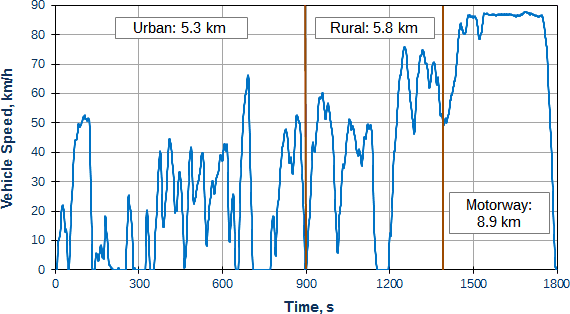World Harmonized Vehicle Cycle (WHVC)
The World Harmonized Vehicle Cycle (WHVC) is a chassis dynamometer test developed based on the same set of data used for the development of the World Harmonized Transient Cycle (WHTC). While the WHVC chassis dynamometer test is not identical to the WHTC engine test, the WHVC results have been occasionally used to compare the respective vehicle and engine emission levels for research purposes.
Vehicle speed over the WHVC test cycle is shown in Figure 1.

The duration of the WHVC test is 1800 s. The test includes three segments, representing urban, rural and motorway driving.
- The first 900 seconds represent urban driving with an average speed of 21.3 km/h and a maximum speed of 66.2 km/h. This segment includes frequent starts, stops and idling.
- The following 481 seconds represent rural driving with an average speed of 43.6 km/h and a maximum speed of 75.9 km/h.
- The last 419 seconds are defined as highway driving with average speed of 76.7 km/h and a maximum speed of 87.8 km/h.
The weighting applied each of the three segments can be varied between 0 and 1 to represent different classes of vehicle operation. The sum of the three weighting factors has to be 1.0.
A slightly modified version of the World Harmonized Vehicle Cycle (WHVC), the C-WTVC (China World Transient Vehicle Cycle), was used for certification purposes in China. Some of the original WHVC acceleration and deceleration values were reduced in the C-WTVC in order to reflect Chinese heavy-duty vehicles; these tend to have lower engine power-to-vehicle weight ratios than heavy vehicles in Europe, North America, and Japan that were used to develop the WHVC. In 2020, the C-WTVC was replaced by the China’s CHTC test cycle.